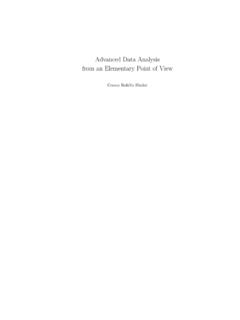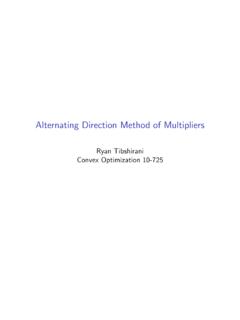Transcription of Structure of a Data Analysis Report
1 Structure of a data Analysis ReportA data Analysis Report is somewhat different from other types of professional writing that you may havedone or seen, or will learn about in the future. It is related to but not the same as: A typical psych/social science paper orgainzed around intro/methods/ Analysis /results/discussio n sections. A research article in an academic journal. An essay. A lab Report in a science overall Structure of a data Analysis Report is simple:1. Introduction2. Body3. Conclusion(s)/Discussion4.
2 Appendix/AppendicesThe data Analysis Report is written for several different audiences at the same time: Primary audience: A primary collaborator or theIntroductionand perhaps theConclusionto find out what you did and what your conclusions were, and then perhaps fishes/skimsthrough theBody, stopping only for some additional details on the parts thathe/she thought wereinteresting or the paper around an agenda for a conversation you want tohave with this person about what you ve learned about their data : , from most general to mostspecific, or from most important to least important, etc.
3 Provide the main evidence from your Analysis (tabular, graphical, or otherwise) in the Bodyto support each point or conclusion you reach, but savemore detailed evidence, and other ancillary material, for the Appendix. Secondary Audience: An executive only skims theIntroductionand perhapsthe ulConclusionto find out what you did and what your conclusions signposts in theIntroduction, Bodyand Conclusionto make it easy for this person to swoop in, find the headlines of your work and conclusions, and swoop back out.
4 Secondary Audience: A technical theBodyand then examines theAppendixfor quality control: How good a job did you do in (raising and)answering the interesting questions?How efficient were you? Did you reach reasonable conclusions by defensible statistical methods? specific cross-references between the Bodyand specific parts of the Appendixso that thisperson can easily find supporting and ancillary material related to each main Analysis you Report inthe Body. Add text to the technical material in the Appendixso that this person sees how and why youcarried out the more detailed work shown in the data Analysis Report has two very important features: It is organized in a way that makes it easy for different audiences to skim/fish through it to find thetopics and the level of detail that are of interest to them.
5 The writing is as invisible/unremarkable as possible, so that the content of the Analysis is what thereader remembers, not distracting quirks or tics in the writing. Examples of distractions include: Extra sentences, overly formal or flowery prose, or at the other extreme overly casual or overlybrief prose. Grammatical and spelling errors. Placing the data Analysis in too broad or too narrow a contextfor the questions of interest to yourprimary audience. Focusing on process rather than reporting procedures and outcomes.
6 Getting bogged down in technical details, rather than presenting what is necessary to properlyunderstand your conclusions on substantive questions of interest to the primary is less important to worry about the latter two items in theAppendix which is expected to be moredetailed and process-oriented. However, there should be enough text annotating the technical materialin the Appendix so that the reader can see how and why you carried out the more detailed work data Analysis Report isn t quite like a research paper orterm paper in a class, nor like a research articlein a journal.
7 It is meant, primarily, to start an organized conversation between you and your that sense it is a kind of internal communication, sort of like an extended memo. On the other hand italso has an external life, informing a boss or supervisor what you ve been let s consider the basic outline of the data Analysis Report in more features for the Introduction include: Summary of the study and data , as well as any relevant substantive context, background , orframing issues. The big questions answered by your data analyses, and summaries of your conclusions aboutthese questions.
8 Brief outline of remainder of above is a pretty good order to present this material in body can be organized in several ways. Here are two that often work well: the body up into several sections at the same level as the Introduction, withnames like: data Methods Analysis ResultsThis format is very familiar to those who have written psych research papers. It often workswell for a data Analysis paper as well, though one problem with it is that the Methods sectionoften sounds like a bit of a stretch: In a psych research paperthe Methods section describeswhat you did to get your data .
9 In a data Analysis paper, you should describe the analyses thatyou performed. Without the results as well, this can be pretty sterile sounding, so I often mergethese methods pieces into the Analysis section when I write. this format there is a single Body section, usually called Analysis ,and then there is a subsection for each question raised in theintroduction, usually taken in thesame order as in the introduction (general to specific, decreasing order of importance, etc.).Within each subsection, statistical method, analyses, andconclusion would be described (foreach question).
10 For example:2. Success Time to Effect of Hospital EffectsMethodsAnalysisConclusionsEtc..Ot her organizational formats are possible too. Whatever the format, it is useful to provide one or twowell-chosen tables or graphs per questionin the body of the Report , for two reasons: First, graphicaland tabular displays can convey your points more efficiently than words; and second, your skimming audiences will be more likely to have their eye caught by an interesting graph or table than by runningtext. However, too much graphical/tabular material will break up the flow of the text and becomedistracting; so extras should be moved to the (s) conclusion should reprise the questions and conclusions of the in-troduction, perhaps augmented by some additional observations or details gleaned from the analysissection.








